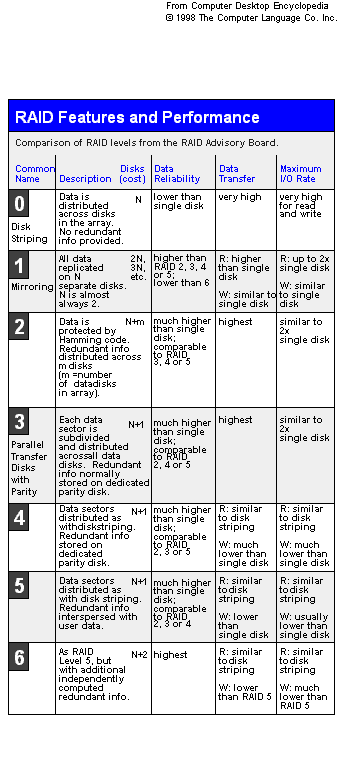| ¡@(Redundant Array of Independent
Disks) A disk subsystem that provides increased
performance and/or fault tolerance. Performance is
improved by disk striping, which interleaves bytes or
groups of bytes across multiple drives, so more than one
disk is reading and writing simultaneously. Fault
tolerance is achieved by mirroring or parity. Mirroring
is 100% duplication of the data on two drives (RAID 1),
and parity calculates the data in two drives and stores
the result on a third drive (a bit from drive 1 is XOR'd
with a bit from drive 2, and the result bit is stored on
drive 3). ¡@A RAID system comprises a RAID controller and two or more regular disk drives. The RAID functionality is built into the controller. RAID can also be implemented in ordinary PCs via software only, but with less efficiency and performance. ¡@RAID systems come in all sizes from floor-standing cabinets to a complete system in one full-size drive bay. Self-contained systems often include large amounts of cache and redundant power supplies. In fault-tolerant configurations such as RAID 3 and 5, a failed drive can be hot swapped with a new one, and the RAID controller automatically rebuilds the lost data. ¡@RAID used to mean arrays of "inexpensive" disks, which was the title of a paper written in 1988 at the University of California at Berkeley. RAIDs were contrasted with SLEDs (Single Large Expensive Disks), which were still popular on large computers. Today, all hard disks are inexpensive by comparison, and the RAID Advisory Board (www.raid-advisory.com) changed the name to "independent" disks. For more details, review the white paper from the RAID Advisory Board at www.raid-advisory.com/rabguide.html.
¡@ RAID LEVEL 0 ¡@Level 0 is disk striping only, which interleaves data across multiple disks for better performance. It does not provide safeguards against failure. RAID LEVEL 1 ¡@Uses disk mirroring, which provides 100% duplication of data. Offers highest reliability, but doubles storage cost. RAID LEVEL 2 ¡@Bits (rather than bytes or groups of bytes) are interleaved across multiple disks. The Connection Machine used this technique, but this is a rare method. RAID LEVEL 3 ¡@Data is striped across three or more drives. Used to achieve the higest data transfer, because all drives operate in parallel. Parity bits are stored on separate, dedicated drives. RAID LEVEL 4 ¡@Similar to Level 3, but manages disks independently rather than in unison. Not often used. RAID LEVEL 5 ¡@Most widely-used. Data is striped across three or more drives for performance, and parity bits are used for fault tolerance. The parity bits from two drives are stored on a third drive. RAID LEVEL 6 ¡@Highest reliability, but not widely used. Similar to RAID 5, but does two different parity computations or the same computation on overlapping subsets of the data. RAID LEVEL 10 ¡@Actually RAID 1,0. A combination of RAID 1 and 0 (mirroring and striping). ¡@ Big RAID Little RAID RAID On a
Budget |
